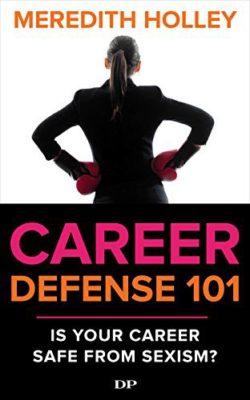 In the #MeToo era, Meredith Holley’s book Career Defense 101 is a book that all should read. Ms. Holley is an attorney that specializes in Sexual Harassment cases. She is also a coach that works with her clients to overcome the trauma that results from sexual harassment so that they can reclaim their lives. The book is crucial for victims of sexual harassment and abuse. For those that have not had the experience, the book is important because Ms. Holley clearly describes, in an oftentimes humorous manner, exactly what complex feelings victims go through. From self-blame to denial to rationalization. No two people will react in the same manner, but everyone should have a defense plan.
In the #MeToo era, Meredith Holley’s book Career Defense 101 is a book that all should read. Ms. Holley is an attorney that specializes in Sexual Harassment cases. She is also a coach that works with her clients to overcome the trauma that results from sexual harassment so that they can reclaim their lives. The book is crucial for victims of sexual harassment and abuse. For those that have not had the experience, the book is important because Ms. Holley clearly describes, in an oftentimes humorous manner, exactly what complex feelings victims go through. From self-blame to denial to rationalization. No two people will react in the same manner, but everyone should have a defense plan.
The first quarter of the book explores Ms. Holley’s own unique upbringing as well as discussions about her clients’ experiences. She acknowledges that women are not the only victims of sexual harassment, but explains that her book will focus on women since they are by far the most affected. She also goes into detail about her early career and how difficult and painful lawsuits can be for victims. Ms. Holley explains how she was driven to find some non-legal way to help her clients “see what superheroes they were” and to get the respect they deserve. This led to her creating career defense strategies.
Ms. Holley has developed seven strategies for combatting sexual harassment. I say combatting because Ms. Holley makes a strong case that we are at a time when the war against sexual harassment is winnable. She believes that by confronting sexual harassment head on (instead of trying to ignore it or hoping it will get better with a new job) women can make strides towards ending harassment for all in the near future. She uses humorous metaphors to explain psychological theories that show why some men continue to engage in harassment and others just turn a blind eye.
The self-help part of the book is the exploration of her seven strategies. For each strategy, Ms. Holley provides the reader with “Action Steps,” which the reader can use to incorporate each strategy into their own life. The action steps require deep thought and soul searching, but are designed to help the reader take charge.
In the final part of the book, Ms. Holley gives a particularly good analogy of how women should perceive their harassers. She suggests the reader view the man’s behavior as coming from an eight-year old boy and then to ask how one would deal with that situation. She also offers effective form letters and e-mails for women to use in their battle against harassment. Each of these forms is meant to help people deal with their harassers head-on and end harassment in their lives. I highly recommend this book.
